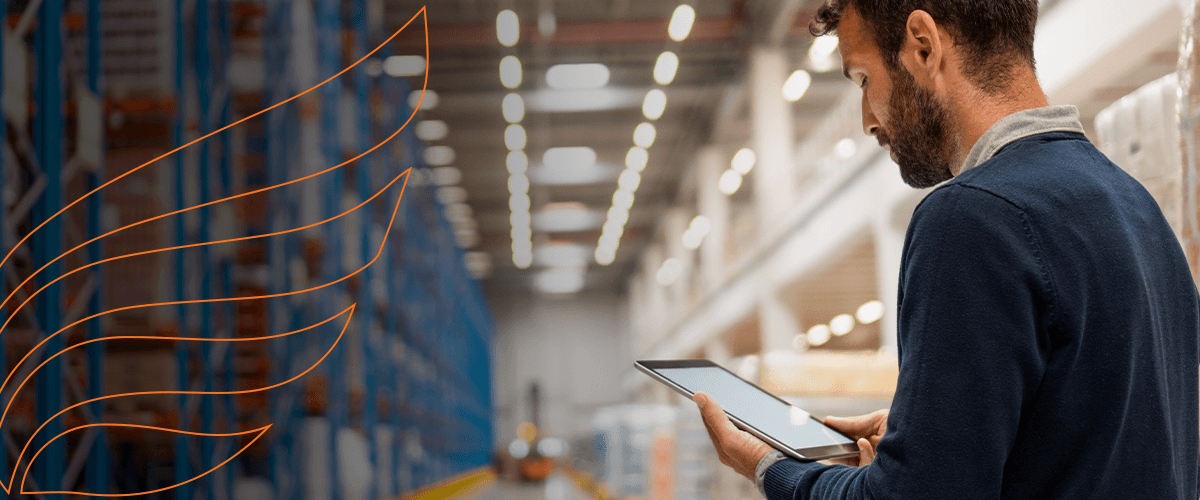
Table of Contents
1. Third-Party Logistics Warehousing
2. Warehouse Management Systems
3. IoT Solutions for Warehouse Management
4. Advanced Inventory Tracking
5. Sustainable Warehousing
6. Greater Cold Storage Demand
7. Supply Chain Visibility
8. Radio Frequency Identification Tracking
9. Mobile Inventory and Assets Management Systems
10. Warehouse Drones
Current and Future Warehouse Industry Trends
The warehouse industry is always transforming and evolving to meet new demands and enhance operations. Major supply chain shifts and changing consumer behavior directly influence how warehousing and storage facilities function.
Rapidly advancing technology and efforts to make operations more transparent are helping warehouses meet new standards and satisfy customers.
In this article, we break down some of the top warehousing industry trends and the impacts they have on storage operations.
View Our Warehousing Solutions
10 Warehousing Trends
Explore some of the top market and industry trends for warehousing:
1. Third-Party Logistics Warehousing
Third-party logistics (3PL) warehousing is growing exponentially as more businesses look for new ways to optimize their supply chains and combat potential complications. Businesses can turn to 3PL warehouse services to relieve some of the stress of managing their supply chain so they can focus on other important areas of their operation.
3PL companies essentially rent out their warehouse space to other businesses looking to outsource their inventory management and final-mile delivery logistics.
In some cases, 3PL businesses will extend their services to a specific industry or type of product. Others offer warehousing across many different industries, such as the following:
- Food
- Beverage
- Pharmaceuticals
2. Warehouse Management Systems
A warehouse management system (WMS) refers to specialized software used to streamline the following operations in a warehouse:
- Receiving
- Storing
- Inventory tracking
- Bar code scanning
- Picking
- Packing
- Shipping
The main goal of a WMS is to enhance operational efficiency while reducing costs. Warehouse automation tools also help businesses optimize labor management while streamlining the relationships between customers and suppliers.
Some WMSs can easily integrate with other solutions, such as enterprise resource planning and transportation management systems.
3. IoT Solutions for Warehouse Management
Over the last few years, businesses have started harnessing the benefits of the Internet of Things (IoT). IoT solutions can help warehouses optimize their processes and take control of their inventory management efforts.
Tools such as smart sensors can help staff closely track their assets by monitoring the following:
- Location
- Temperature
- Moisture content
- Lighting
IoT solutions allow teams to access real-time data about their products and ensure all systems are functioning optimally. Newer IoT tools, such as smart shelves, can help businesses track product information, like when inventory needs replacing.
4. Advanced Inventory Tracking
The warehousing industry is using advanced inventory tracking processes to gain greater control over the movement of goods and products.
Inventory management systems are more connected than ever before, helping businesses gain real-time insights into the following:
- Inventory levels
- Locations
- Pricing
- Supply chain factors
Businesses can harness advanced technology like cloud-based software to carry out more accurate inventory management practices and make more informed decisions.
Improving inventory tracking lets warehouse operations do the following:
- Improve speed
- Become more cost-effective
- Enhance supply chain and distribution reliability
- Harness greater precision
![]()
5. Sustainable Warehousing
Sustainability is another top trend in the warehousing industry. In recent years, there has been a push to make changes that reduce the industry’s negative environmental impacts and improve energy efficiency.
The rise of automation and robotics is helping businesses optimize their operations to minimize waste and energy consumption. The following are examples of popular warehouse upgrades to go greener:
- Installing solar panels
- Using electric forklifts and equipment
- Switching to LED lighting
- Recycling and reusing materials when possible
- Upgrading to a cool roof
More warehouses are prioritizing minimizing their carbon footprints and changing their operations to be friendlier to the planet.
6. Greater Cold Storage Demand
Consumer demand for frozen food skyrocketed during the pandemic and has continued to grow throughout the last few years.
As the market for frozen food grows, so does the need for cold storage facilities that can accommodate these products.
The boom in frozen products is so great that cold storage industry trends project a compound annual growth rate of 13.47% from 2023 to 2027. New cold storage facilities are popping up across the country to keep up with the unprecedented growing demand of the frozen industry.
Temperature control and cold storage solutions are becoming an important aspect of the warehousing sector.
Cold Storage in Albuquerque, NM
7. Supply Chain Visibility
After dealing with major supply chain issues due to pandemic-related complications, warehouse operations and demands have changed. Supply chain visibility is essential to the warehousing industry today.
Businesses must understand the path of their supply chain in order to reap the following benefits:
- Greater inventory control
- Improved efficiency
- Reduced costs
- Boosted profitability
- Better customer service
Supply chain visibility helps warehouses gain insight into the important data that impacts decision-making and customer satisfaction.
Advancements in automation are making the process of tracking inventory through the supply chain easier for many companies.
8. Radio Frequency Identification Tracking
Radio frequency identification (RFID) is a highly advantageous technology involving a specialized reader and bar codes to track inventory extremely accurately.
The warehousing and storage market is increasingly using RFID technology to record products coming in and out of the facility automatically. This tool can help eliminate human error and plays a key role in streamlining efficient warehouse operations.
9. Mobile Inventory and Assets Management Systems
Using mobile devices, namely smartphones, equipped with software for inventory and asset management tasks is another growing trend in the warehousing and storage industry.
Smartphones make performing a wide range of operations easy because workers have everything they need at their fingertips. Some key uses for mobile devices in warehousing include:
- Scanning barcodes and QR codes.
- Tracking product specifications.
- Recording inventory levels.
- Sharing real-time updates.
- Collecting data.
Since smartphones are small, your team can easily maneuver around the warehouse with the devices in hand.
10. Warehouse Drones
Drones are among the latest technology to enter warehouses across the country. This equipment is becoming increasingly popular because it can assist with the following:
- Security: Drones are a great tool for boosting warehouse security and can be used to assist with surveillance efforts.
- Accessibility: Warehousing operations utilize drones for picking, packing and inventory management applications.
- Warehouse condition monitoring: You can also use drones to help monitor important aspects of the warehouse environment, such as moisture content and air quality.
Turn to Flagship Logistics Group For Storage and Warehousing Services
If your business needs warehousing services in Albuquerque, New Mexico, turn to Flagship Logistics Group. We have over 30 years of experience as a national logistics and warehousing provider.
We can help protect your products with organic-certified and food-grade cold and dry storage warehousing. Our team prioritizes excellent customer service and will go above and beyond for your business. We use state-of-the-art technology and innovations to increase visibility and enhance your operations.
Are you interested in learning more about warehousing services from Flagship Logistics Group? Contact us to get started today!
This article is intended for informational purposes only, and it might not reflect the technology currently used at Desert Premium Logistics. Please contact us if you have any questions about our warehouse.
